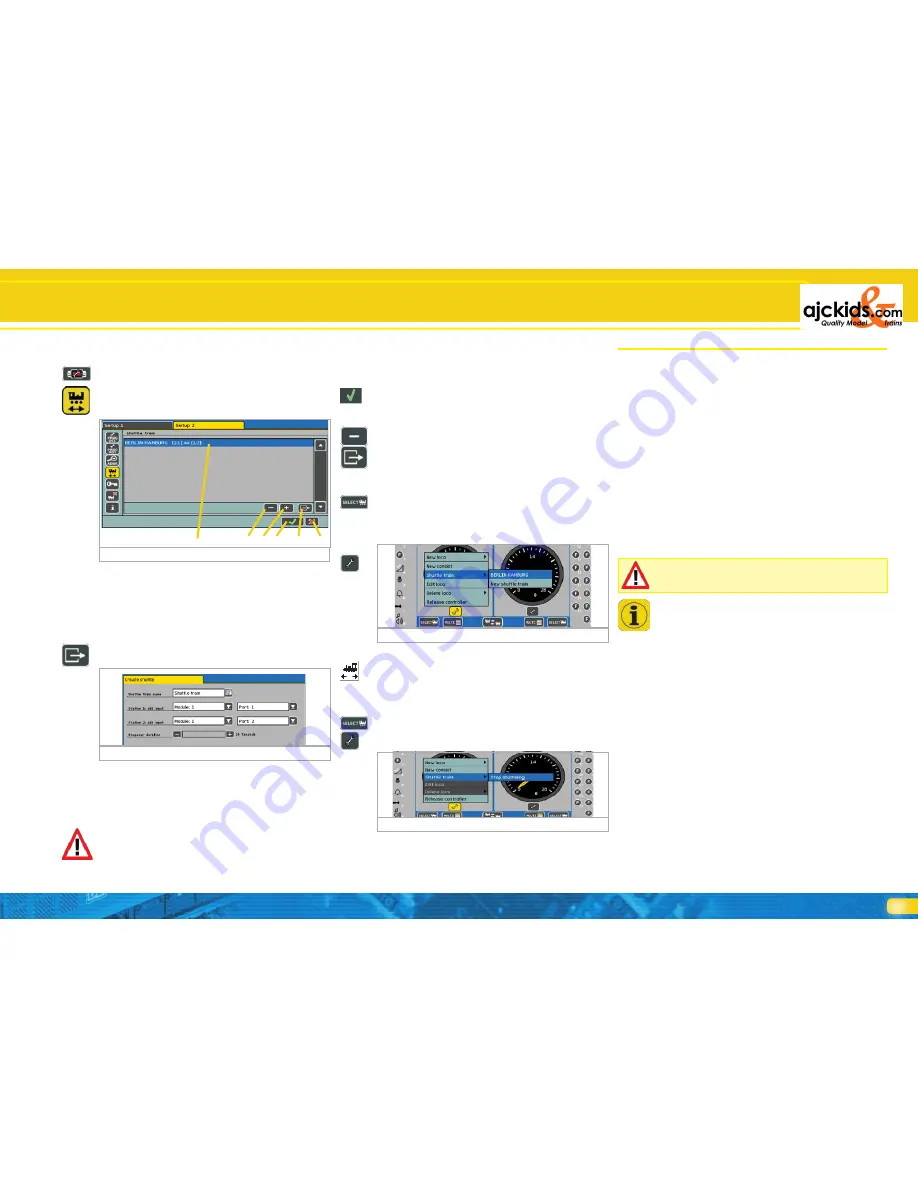
29
17.1. Configuring a shuttle train line
A shuttle train line can easily be configured:
• Select the set-up symbol from the top tool bar. A window with
several pictograms located on the left opens.
• First select “Set-up 2“ at the top, then the fourth pictogram
from the top. Then the “Shuttle train” dialogue window will
open.
a) Shuttle train lines that are already configured
b) Delete a shuttle train line
c) Add a shuttle train line
d) Edit a shuttle train line
e) Leave the set-up menue and save changes
f) Leave the set-up menue and cancel changes
Pushing this screen button opens the sub-window „Shuttle
Train Line“.
Name of the (shuttle train) line
Assign explicit names to your shuttle train lines. This name is
required later for assigning the line.
Station1
: s88-contact and
Station2:
s88-contact
Here you select the two s88-contacts for the brake points of
the shuttle train line. The s88-bus must be correctly configured
prior to this action. See also chapter 22.
Use two separate s88-contacts. ECoS does not check if these
contacts are used for any other action.
b)
e)
Figure 79
d)
f)
a)
c)
Layover time in the stations
Here you enter the time T1+T2 (in total). This may be up to
300 seconds.
Finish your data entry, the window closes and the new shuttle
train line is displayed on the screen. Enter other shuttle train
lines in a similar fashion.
ECoS can handle up to 8 shuttle train lines.
Pushing this symbol for the marked shuttle train line deletes
it.
Open and edit the marked shuttle train line with this symbol.
17.2. Locos travel „out-and-back”
Once you have configured your „shuttle train lines” you may
dispatch a train.
• Call up the loco onto one of the two cabs.
• Move the loco into the shuttle train mode.
• Set the throttle to the desired speed.
• Select „Shuttle Train Line” from the menue.
• Choose the desired Shuttle Train Line from the sub menue.
• Now the locomotive will be controlled by the Shuttle Train Line
control function and cannot be controlled manually any longer.
An icon on the speedometer indicates this.
17.3. Cancel shuttle train mode
If you wish to run this loco manually again proceed as follows:
• Call up the loco on the same throttle that you used to set up
the shuttle train mode.
• Select „Shuttle Train Line” in the locomotive menue.
• Select „Cancel Shuttle Train Mode”
• Now the loco can be controlled manually.
Figure 82
18. Programming Decoders
By programming we mean the method of electronically chan-
ging certain parameters of decoders. This applies to all types
of decoders such as mobile decoders, accessory decoders and
feedback decoders. Decoders with manual switches (DIP-swit-
ches) such as older models from Märklin® cannot be program-
med with ECoS.
Unfortunately there is no standardised method to access all
parameters; this varies subject to the manufacturer and deco-
der type.
Generally it can be said that all parameters of a decoder are
stored in an internal memory space. Each memory space can
contain a number. The memory spaces are numbered in se-
quence. Since the value of each memory space can be changed
at any time they are also know as variables. With these variables
the properties of the decoder are defined („configured”) and
thus the term „Configuration Variable” (CV) was introduced.
The values stored in each CV determine the behaviour of the
decoder to a great deal. Values that are not permitted or wrong
may cause havoc to the point that the decoder does not work
properly or not at all any more.
Change decoder settings only if you are certain about the
consequences. Otherwise you may experience all sorts of un-
explainable behaviour.
In the DCC standards the properties resp. characteristics of
most CVs are defined. A complete list of all CVs and further
information to the DCC standards is available
www.nmra.org/standards/DCC
Please also refer to your decoder manual. There you will find all
supported CVs as well as their meaning.
18.1. DCC-Programming
The range of possibilities in programming DCC decoders has
continuously improved over the years. Therefore there are dif-
ferent methods that are incompatible to each other:
Register Mode: Here you can only access CVs 1 to 8.
Paged Mode: On the programming track CVs 1 to 1024 can
be reached
Direct Mode: On the programming track CVs1 to1024 can
be reached. Reading out decoder data is about
8-times faster than in Paged Mode.
POM Mode:
Here programming is done on the main line
(„Programming On Main“). All CVs from 2 to
1024 can be overwritten. The base address
CV1 cannot be accessed.
Unfortunately there is no rule regarding the fact which decoder
supports which programming method. For new decoders the
Direct Mode is compulsory. All ESU decoders support Direct
Mode as well as the other methods.
„Shuttle Train” Mode & Programming Decoders
Figure 80
Figure 81






























